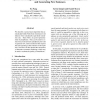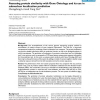820 search results - page 30 / 164 » Using Multiple Alignments to Improve Gene Prediction |
NAACL
2003
2003
Syntax-based Alignment of Multiple Translations: Extracting Paraphrases and Generating New Sentences
13 years 8 months ago
We describe a syntax-based algorithm that automatically builds Finite State Automata (word lattices) from semantically equivalent translation sets. These FSAs are good representat...
BMCBI
2006
13 years 7 months ago
2006
Background: In the area of protein structure prediction, recently a lot of effort has gone into the development of Model Quality Assessment Programs (MQAPs). MQAPs distinguish hig...
BMCBI
2006
13 years 7 months ago
2006
Background: The accomplishment of the various genome sequencing projects resulted in accumulation of massive amount of gene sequence information. This calls for a large-scale comp...
BMCBI
2005
13 years 7 months ago
2005
Background: In the clinical context, samples assayed by microarray are often classified by cell line or tumour type and it is of interest to discover a set of genes that can be us...
BMCBI
2004
13 years 7 months ago
2004
Background: The prediction of ancestral protein sequences from multiple sequence alignments is useful for many bioinformatics analyses. Predicting ancestral sequences is not a sim...


